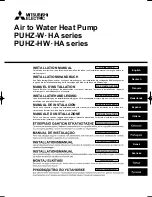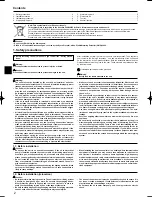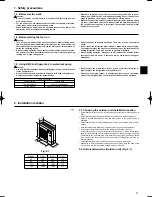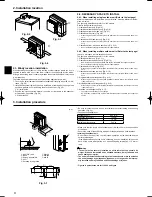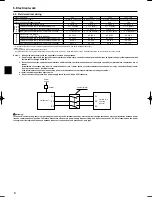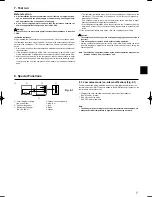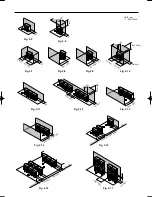
B
330+30
A
C
600
370
Models
A
(mm)
B
(mm)
C
(mm)
50
740
950
175
85
943
950
175
112
1350
1020
210
140
1350
1020
210
3
1. Safety precautions
2. Installation location
Fig. 2-1
2.1. Choosing the outdoor unit installation location
•
Avoid locations where the unit is exposed to direct sunlight or other sources of
heat.
•
Select a location where noise emitted by the unit does not disturb neighbors.
•
Select a location where easy wiring and pipe access to the power source is
available.
•
Avoid locations where combustible gases may leak, be produced,
fl
ow, or accu-
mulate.
•
Note that condensate water may be produced by the unit during operation.
•
Select a level location that can bear the weight and vibration of the unit.
•
Avoid locations where the unit can be covered with snow. In areas where heavy
snow fall is anticipated, special precautions must be taken to prevent the snow
from blocking the air intake such as to install the unit at higher position or install-
ing a hood on the air intake. This can reduce the air
fl
ow and the unit may not
operate properly.
•
Avoid locations where the unit is exposed to oil, steam, or sulfuric gas.
•
Make sure to hold the handles to transport the unit. Do not hold the base of the
unit, as there is a risk that hands or
fi
ngers may be pinched.
2.2. Outline dimensions (Outdoor unit) (Fig. 2-1)
1.3. Before electric work
Caution:
•
Be sure to install a circuit breaker. If it is not installed, there may be a risk
of an electric shock.
•
For the power lines, use standard cables of suf
fi
cient capacity. Otherwise,
it may cause a short circuit, overheating, or
fi
re.
•
When installing the power lines, do not apply tension to the cables. The
cables may be cut or overheated resulting in a
fi
re.
•
Make sure to ground the unit. Do not connect the ground wire to gas or
water pipes, lightning rods, or telephone grounding lines. If the unit is not
properly grounded, there may be a risk to get an electric shock.
•
Make sure to use circuit breakers (ground fault interrupter, isolating switch
(+B fuse), and molded case circuit breaker) with the speci
fi
ed capacity. If
the circuit breaker capacity is larger than the specified capacity, break-
down or
fi
re may result.
1.4. Before starting the test run
Caution:
•
Turn on the main power switch more than 12 hours before starting opera-
tion. Starting operation immediately after turning on the power switch can
severely damage the internal parts. Keep the main power switch turned on
during the operating period.
•
Before starting operation, check that all panels, guards and other protec-
tive parts are correctly installed. Make sure not to get injured by touching
rotating, hot, or high voltage parts.
•
Do not touch any switch with wet hands. There may be a risk of an electric
shock.
•
Do not touch the refrigerant pipes with bare hands while unit is running.
The refrigerant pipes can be hot or cold depending on the condition of the
fl
owing refrigerant. There may be a risk to get burn or frostbite.
•
After stopping operation, make sure to wait at least five minutes before
turning off the main power. Otherwise, it may cause water leakage or
breakdown.
1.5. Using R410A refrigerant air to water heat pump
Caution:
•
Use only R410A refrigerant. If another refrigerant is used, the chlorine will
let the oil deteriorate.
•
Use the following tools specifically designed for R410A refrigerant use.
Contact your nearest installer for further details.
Tools (for R410A)
Gauge manifold
Charge hose
Gas leak detector
Vacuum pump adapter
Torque wrench
Electronic refrigerant charging scale
•
Be sure to use the proper tools. If dust, debris, or moisture enters the re-
frigerant pipes, the refrigeration oil may deteriorate.
•
Do not use a charging cylinder. If a charging cylinder is used, the compo-
sition of the refrigerant may change and the ef
fi
ciency will be worsened.
(mm)
01̲ BH79D067L02̲EN.indd 3
01̲ BH79D067L02̲EN.indd 3
2009/06/03 9:50:56
2009/06/03 9:50:56
Содержание PUHZ-HW*HA series
Страница 8: ......

